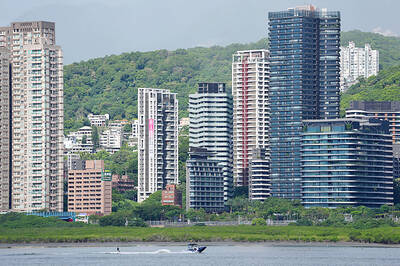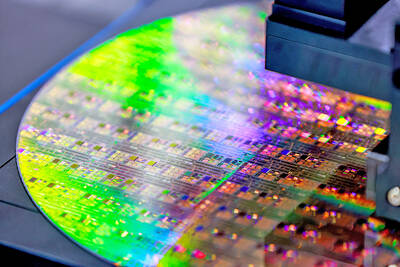With US President Donald Trump threatening to impose tariffs on semiconductors, Taiwan is expected to face a significant challenge, as information and communications technology (ICT) products account for more than 70 percent of its exports to the US, Chung-Hua Institution for Economic Research (CIER, 中華經濟研究院) president Lien Hsien-ming (連賢明) said on Friday.
Compared with other countries, semiconductors play a disproportionately large role in Taiwan’s industrial and economic development, Lien said.
As the sixth-largest contributor to the US trade deficit, Taiwan recorded a US$73.9 billion trade surplus with the US last year — up from US$47.8 billion in 2023 — driven by strong US demand for artificial intelligence (AI) servers and semiconductors, he said.

Photo: I-HWA CHENG, AFP
“I think Trump really cares about a trade deficit resulting from purchases of high-tech goods such as semiconductors,” Lien said, referring to the investigation launched in April under Section 232 of the Trade Expansion Act of 1962, which targets the ICT sector — particularly semiconductors — for potential tariffs.
After the tariff was set at 20 percent — down from the 32 percent Trump announced on April 2 — President William Lai (賴清德) said the measure is provisional and Taiwan would continue negotiations with the US to seek a lower rate.
Taiwan’s negotiating team would engage directly with its US counterparts on the semiconductor issue, Lai said.
Lien said that Lai’s remarks show the government is concerned about the threat a chip-specific tariff could pose to Taiwan’s economy.
Aligning with this view, CIER vice president Chen Shin-horng (陳信宏) said that based on the US approach to trade negotiations, sector-specific tariffs, such as those on semiconductors, are likely to be set higher than across-the-board levies.
For example, while Japan’s overall tariff has been reduced from 25 percent to 15 percent, the levy on steel and aluminum remains at 50 percent, as Trump seeks to revive the US “Rust Belt,” Chen said.
Trump has used the threat of tariffs under Section 232 of the Trade Expansion Act of 1962 to force countries with industry-specific strengths and financial resources into making large-scale investments in the US, Chen said.
Although the US is aware that foreign semiconductor or AI server manufacturers are unlikely to build new facilities in the short term, a tariff under Section 232 could be set at a relatively low level and gradually increased over the next two to three years, he added.
Taiwan Semiconductor Manufacturing Co (TSMC, 台積電), which is investing US$65 billion in Arizona and has pledged an additional US$100 billion, has warned Washington that imposing tariffs on Taiwanese semiconductors could dampen demand and jeopardize its expansion plans in the state.
“New import restrictions could jeopardize current US leadership in the competitive technology industry and create uncertainties for many committed semiconductor capital projects in the US, including TSMC Arizona’s significant investment plan in Phoenix,” the chipmaker wrote in a letter to the US Department of Commerce in May.
US Secretary of Commerce Howard Lutnick said at the end of last month that the results of the Section 232 investigation would be released within two weeks, ahead of any decision to impose tariffs on semiconductor imports.

Taiwan’s rapidly aging population is fueling a sharp increase in homes occupied solely by elderly people, a trend that is reshaping the nation’s housing market and social fabric, real-estate brokers said yesterday. About 850,000 residences were occupied by elderly people in the first quarter, including 655,000 that housed only one resident, the Ministry of the Interior said. The figures have nearly doubled from a decade earlier, Great Home Realty Co (大家房屋) said, as people aged 65 and older now make up 20.8 percent of the population. “The so-called silver tsunami represents more than just a demographic shift — it could fundamentally redefine the

The US government on Wednesday sanctioned more than two dozen companies in China, Turkey and the United Arab Emirates, including offshoots of a US chip firm, accusing the businesses of providing illicit support to Iran’s military or proxies. The US Department of Commerce included two subsidiaries of US-based chip distributor Arrow Electronics Inc (艾睿電子) on its so-called entity list published on the federal register for facilitating purchases by Iran’s proxies of US tech. Arrow spokesman John Hourigan said that the subsidiaries have been operating in full compliance with US export control regulations and his company is discussing with the US Bureau of

Businesses across the global semiconductor supply chain are bracing themselves for disruptions from an escalating trade war, after China imposed curbs on rare earth mineral exports and the US responded with additional tariffs and restrictions on software sales to the Asian nation. China’s restrictions, the most targeted move yet to limit supplies of rare earth materials, represent the first major attempt by Beijing to exercise long-arm jurisdiction over foreign companies to target the semiconductor industry, threatening to stall the chips powering the artificial intelligence (AI) boom. They prompted US President Donald Trump on Friday to announce that he would impose an additional

Pegatron Corp (和碩), a key assembler of Apple Inc’s iPhones, on Thursday reported a 12.3 percent year-on-year decline in revenue for last quarter to NT$257.86 billion (US$8.44 billion), but it expects revenue to improve in the second half on traditional holiday demand. The fourth quarter is usually the peak season for its communications products, a company official said on condition of anonymity. As Apple released its new iPhone 17 series early last month, sales in the communications segment rose sequentially last month, the official said. Shipments to Apple have been stable and in line with earlier expectations, they said. Pegatron shipped 2.4 million notebook